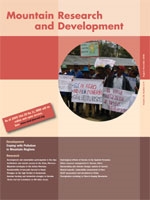Focus Issue: Coping with Pollution in Mountain Regions
Editorial (1)
Development (7)
Research (13)
MountainPlatform (2)
MountainNotes (1)
MountainMedia (7)

No abstract available
No abstract available
No abstract available
No abstract available
No abstract available
No abstract available
No abstract available
No abstract available
No abstract available
No abstract available
No abstract available
